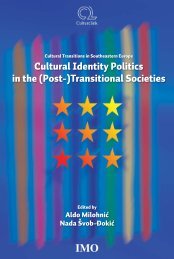D:\Documents and Settings\Ana\My Documents\Biserka-knjiga ...
D:\Documents and Settings\Ana\My Documents\Biserka-knjiga ...
D:\Documents and Settings\Ana\My Documents\Biserka-knjiga ...
Create successful ePaper yourself
Turn your PDF publications into a flip-book with our unique Google optimized e-Paper software.
Digital Culture: The Changing Dynamics<br />
These areas of expertise are not within most curators’ job descriptions <strong>and</strong> they<br />
don’t need to be. They simply need to underst<strong>and</strong> the potential of the wiki as a tool,<br />
they don’t need to know how to actually build one themselves. Maybe what that<br />
curator needs is support from someone who has the skills to build one, who they can<br />
work with to make sure that the wiki is the right tool for the job <strong>and</strong> answers a real<br />
need?<br />
This kind of collaborative working <strong>and</strong> skill sharing, within a practical context, is<br />
fundamental to the successful adoption <strong>and</strong> implementation of a digital publishing<br />
agenda in the cultural sector. The people working, running <strong>and</strong> managing our cultural<br />
organizations need to underst<strong>and</strong> it enough so that they can exploit the technology to<br />
their advantage without feeling they have to jump on every new b<strong>and</strong>wagon that<br />
comes along.<br />
A really nice example of collaborative working <strong>and</strong> skills development is the<br />
National Museums Liverpool Blog. 7 Here, staff are working together to publish a<br />
blog about their activities. They are tagging stories, sharing experiences. It is low<br />
tech, low cost, low risk but high impact as the nature of a blog is that it is visible to<br />
search engines because of the way they are built. It is also only a part of their overall<br />
online activities, which also include RSS 8 feeds, online collections, events <strong>and</strong> a more<br />
formal brochure site. Individually they are all simple but together they create a<br />
sophisticated online offering that gives them a well-optimized Web presence.<br />
Learning how to work with technology in this kind of open, flexible <strong>and</strong> collaborative<br />
way is something that the cultural sector is going to need to do more of, <strong>and</strong> soon.<br />
Aside from a growing h<strong>and</strong>ful of cultural sector blogs, the Web 2.0 phenomenon<br />
has facilitated millions of people online to share their own personal content – stories,<br />
ideas, rants <strong>and</strong> trivia. Technorati 9 currently tracks over 57 million weblogs <strong>and</strong> the<br />
blogosphere continues to double about every five months. But does any cultural<br />
content play a role in these blogs? Do bloggers want access to cultural stuff or are they<br />
busy with other things?<br />
Changing user behaviour on the 24 Hour Museum website<br />
At Culture24 we publish a website called the 24 Hour Museum 10 <strong>and</strong> we found in the<br />
last three years that we share a lot of traffic with blogs, although to find the touch<br />
7 http://blog.liverpoolmuseums.org.uk/<br />
8 RSS is a format for delivering regularly changing web content. Many news-related sites,<br />
weblogs <strong>and</strong> other online publishers syndicate their content as an RSS Feed to whoever<br />
wants it.<br />
9 http://technorati.com/<br />
10 http://www.24hourmuseum.org.uk<br />
154



